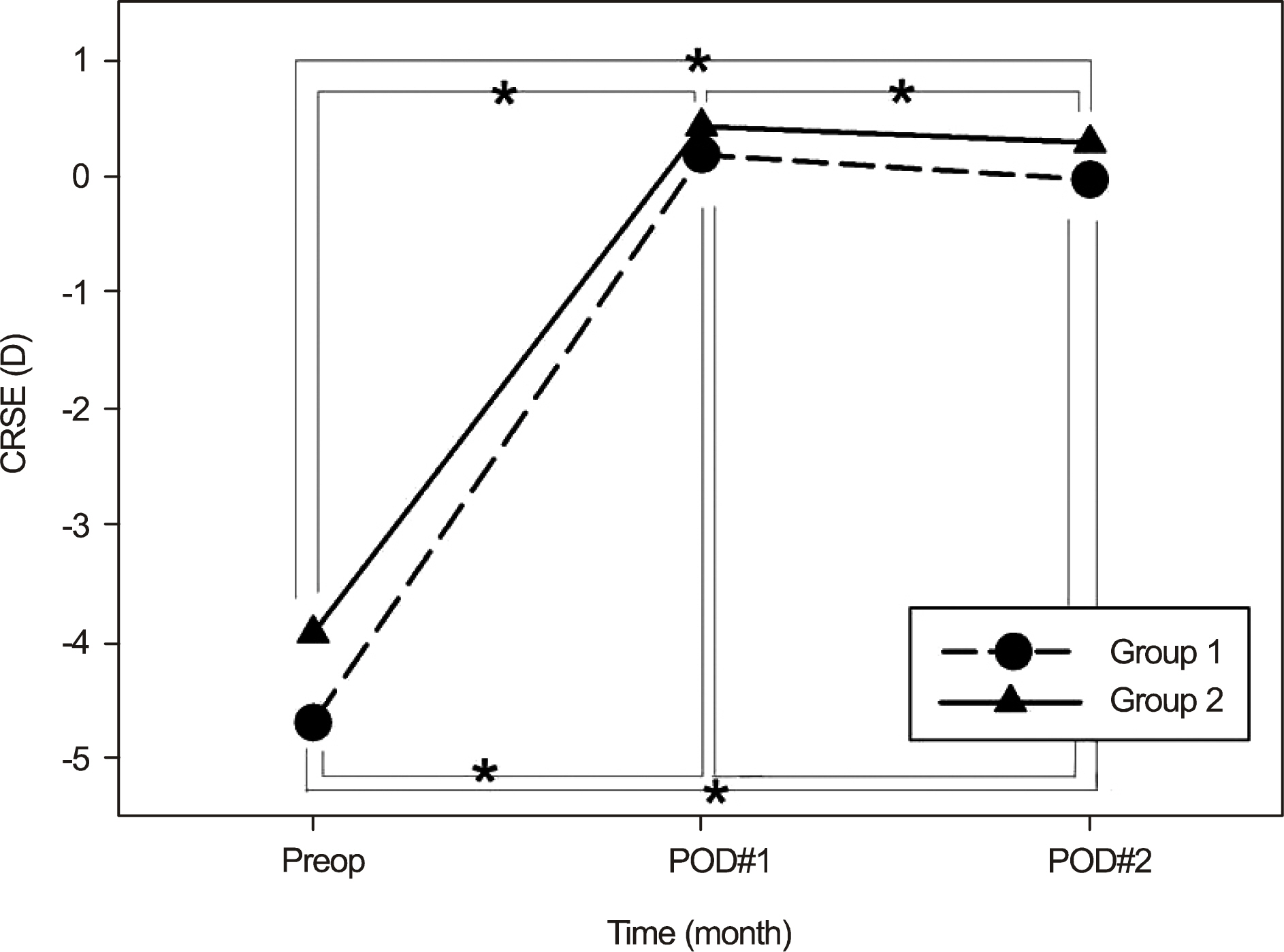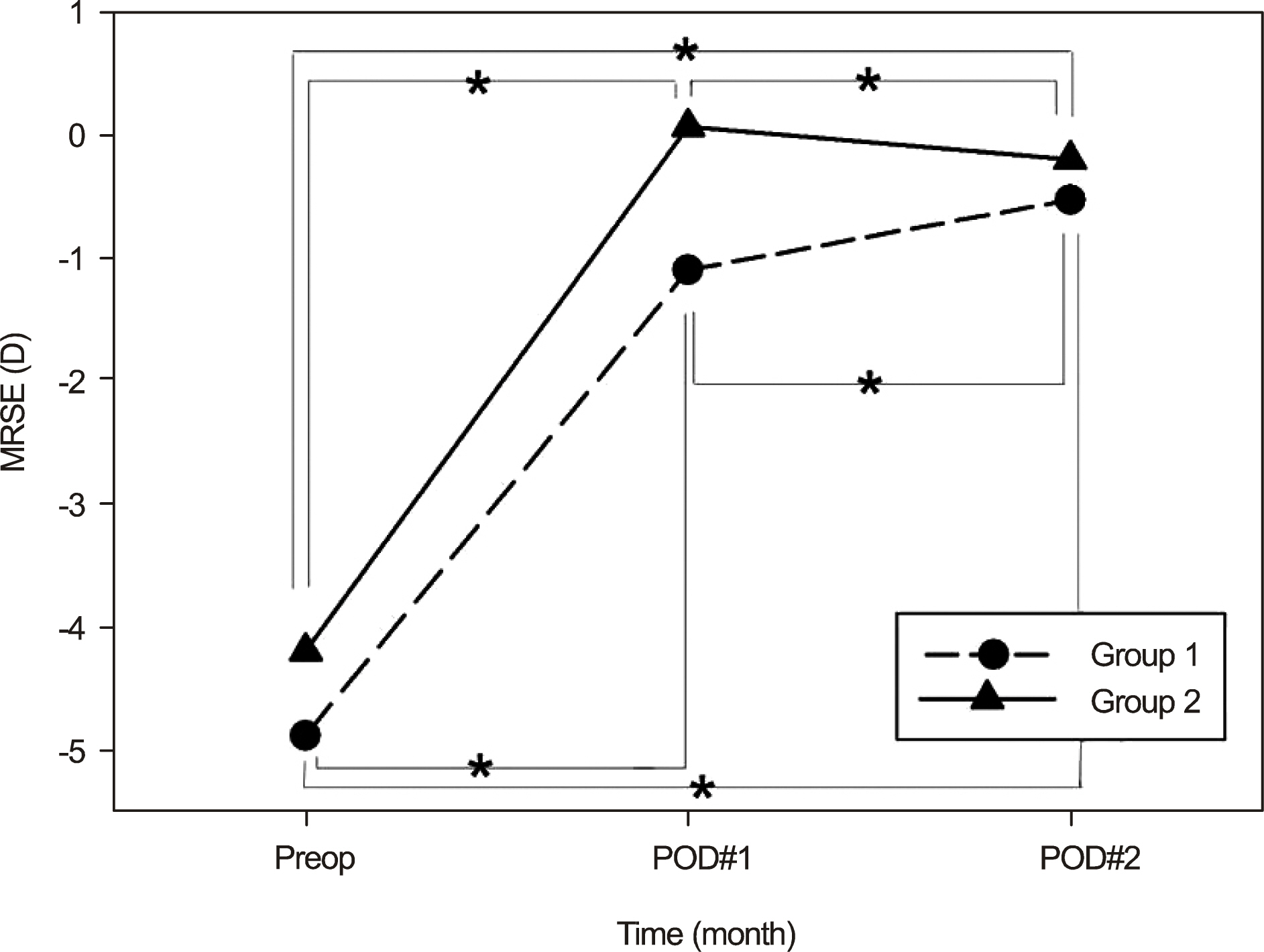J Korean Ophthalmol Soc.
2014 Jan;55(1):40-46.
Transient Myopic Shift Due to Increased Latent Accommodation after LASEK
- Affiliations
-
- 1Department of Ophthalmology, The Institute of Vision Research, Yonsei University College of Medicine, Seoul, Korea.
- 2Siloam Eye Hospital, Seoul, Korea. pushong@daum.net
Abstract
- PURPOSE
To investigate accommodation and progress of patients who showed myopia on manifest refraction in the early postoperative period after LASEK.
METHODS
Forty-one eyes were included in the present study which had undergone LASEK surgery from February to March 2012. Seven eyes showed myopia over -0.25 D on manifest refraction at 1 month postoperatively, but showed decreased amount of myopia at 2 months postoperatively and were classified as group 1. The other 34 eyes were classified as group 2. The differences between cycloplegic and manifest refraction (CRSE-MRSE) were defined as the amount of latent accommodation and compared between the 2 groups.
RESULTS
Amount of latent accommodation was 0.179 +/- 0.426 D in group 1 (7 eyes), 0.265 +/- 0.303 D in group 2 (34 eyes) preoperatively, 1.286 +/- 0.664 D in group 1, 0.368 +/- 0.536 D in group 2 at 1 month postoperatively, and 0.500 +/- 0.520 D in group 1, and 0.489 +/- 0.546 D in group 2 at 2 months postoperatively. The amount of latent accommodation in group 1 was significantly greater than that of group 2 one month postoperatively. As the amount of latent accommodation decreased, the amount of myopic shift decreased gradually over 2 months in group 1 after surgery.
CONCLUSIONS
Transient myopic shift due to increased latent accommodation was observed in several patients one month postoperatively and the amount of myopic shift decreased with time without treatment. Thus, surgeons should consider cycloplegic refraction when planning treatment for patients with myopic regression.
Keyword
Figure
Reference
-
References
1. Shojaei A, Eslani M, Vali Y. . Effect of timolol on refractive outcomes in eyes with myopic regression after laser in situ kerato-mileusis: a prospective randomized clinical trial. Am J Ophthalmol. 2012; 154:790–8.e1.
Article2. Hiatt JA, Wachler BS, Grant C.Reversal of laser in situ keratomi-leusis-induced ectasia with intraocular pressure reduction. J Cataract Refract Surg. 2005; 31:1652–5.
Article3. Kamiya K, Aizawa D, Igarashi A. . Effects of antiglaucoma drugs on refractive outcomes in eyes with myopic regression after laser in situ keratomileusis. Am J Ophthalmol. 2008; 145:233–8.
Article4. Bailey MD, Twa MD, Mitchell GL. . Repeatability of autore-fraction and axial length measurements after laser in situ keratomileusis. J Cataract Refract Surg. 2005; 31:1025–34.
Article5. Shin KM, Chung SA, Lee JB.Comparative study on the efficacy of different cycloplegic agents in myopic adults. J Korean Ophthalmol Soc. 2011; 52:141–6.
Article6. Hamasaki I, Hasebe S, Kimura S. . Cycloplegic effect of 0.5% tropicamide and 0.5% phenylephrine mixed eye drops: objective assessment in Japanese schoolchildren with myopia. Jpn J Ophthalmol. 2007; 51:111–5.7. Airiani S, Braunstein RE.Accommodative spasm after laser-as-sisted in situ keratomileusis (LASIK). Am J Ophthalmol. 2006; 141:1163–4.
Article8. Prakash G, Sharma N, Sharma P. . Accommodative spasm after laser-assisted in situ keratomileusis (LASIK). Am J Ophthalmol. 2007; 143:540. author reply -1.
Article9. Goldstein JH, Schneekloth BB.Spasm of the near reflex: a spec-trum of anomalies. Surv Ophthalmol. 1996; 40:269–78.
Article10. Rutstein RP, Marsh-Tootle W.Acquired unilateral visual loss at-tributed to an accommodative spasm. Optom Vis Sci. 2001; 78:492–5.
Article11. Faucher C, De Guise D.Spasm of the near reflex triggered by dis-ruption of normal binocular vision. Optom Vis Sci. 2004; 81:178–81.
Article12. Monteiro ML, Curi AL, Pereira A. . Persistent accommodative spasm after severe head trauma. Br J Ophthalmol. 2003; 87:243–4.
Article13. Chan RV, Trobe JD.Spasm of accommodation associated with closed head trauma. J Neuroophthalmol. 2002; 22:15–7.
Article14. Anderson HA, Hentz G, Glasser A. . Minus-lens-stimulated accommodative amplitude decreases sigmoidally with age: a study of objectively measured accommodative amplitudes from age 3. Invest Ophthalmol Vis Sci. 2008; 49:2919–26.
Article15. Salchow DJ, Zirm ME, Stieldorf C, Parisi A.Comparison of ob-jective and subjective refraction before and after laser in situ keratomileusis. J Cataract Refract Surg. 1999; 25:827–35.
Article16. Miranda MN.Residual accommodation. A comparison between cyclopentolate 1 per cent and a combination of cyclopentolate 1 per cent and tropicamaide 1 per cent. Arch Ophthalmol. 1972; 87:515–7.17. Yang SW, Lee NY, Kim SY.The effect of cycloplegia on vision and stereopsis: comparison between before and after cycloplegia. J Korean Ophthalmol Soc. 2006; 47:1454–8.
- Full Text Links
- Actions
-
Cited
- CITED
-
- Close
- Share
- Similar articles
-
- Acute Transient Myopic Shift in a Patient With Fever of Unknown Origin: A Case Report
- Two Year Clinical Results of LASEK (Laser Epithelial Keratomileusis) for Correcting Myopia
- The Effect of Anti-glaucoma Eyedrops and 0.1% Fluorometholone on Myopic Regression after LASIK or LASEK
- Study on Lens Thickness and Anterior Chamber Depth during Accommodation and Weak Cycloplegic Eyes
- Comparative Study on the Efficacy of Different Cycloplegic Agents in Myopic Adults




